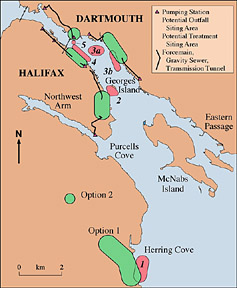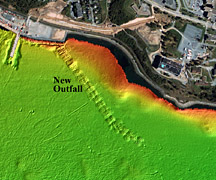Common menu bar links
Cleanup and Collaboration

Halifax Harbour receives approximately 170 million liters of raw sewage per day from a total of 50 outfalls from the surrounding communities of Halifax and Dartmouth. There are two small sewage treatment plants in Bedford and Eastern Passage. Over the past 30 years, many advisory groups have been set up to provide guidance on the design of a wastewater-treatment facility for the harbour, however, most failed to bring about active construction of a facility, and the discharge of raw sewage continued to represent one of Canada's most serious coastal environmental problems.

A map of part of Halifax Harbour showing the recommended locations for sewage treatment plants and marine outfalls based on recommendations of the Halifax Harbour Solutions Advisory Committee. Options 1, 3 and 4 are presently under construction.
The Geological Survey of Canada participated as an active member of the last two major study groups, the "Halifax Harbour Task Force" and the "Solutions Advisory Committee", in assessing the marine environmental quality of the harbour. They conducted additional research on the marine geology and geochemistry. From a study of the distribution of sediments, features such as bedforms and geochemical anomalies, and multibeam bathymetry, sediment transport pathways were defined. These data suggest northward migration of silt and clay particles and the containment of trace metals and organic contaminants within the inner harbour. In the outer harbour, sediments consist of clean, sorted sands, gravels and exposed bedrock. Areas of sediment deposition are clearly defined.
The Task Force recommended a new location for one consolidated sewage outfall in the inner harbour. This decision was unconventional to many accepted practices, where sewage outfalls are located as far out to sea as possible. The recommendation was based upon trying to contain the waste rather than to disperse it.
The construction of one wastewater-treatment facility was soon abandoned due to high costs and a lack of political will. A subsequent "Harbour Solutions Advisory Committee" was appointed and recommended a multiplant scenario. A major constraint on the location of these plants (3 to 5) was the location of suitable outfall sites on the nearby seabed. The geological information was once again used to determine appropriate sites for these new outfalls. The criteria included suitable foundation characteristics, maximum dilution, location in an area of no sediment deposition, and distance from designated anchorages.

A multibeam bathymatric image from inner Halifax Harbour off the location of the new sewage treatment plant in Dartmouth showing the new outfall placed on the seabed.
As of 2007, three wastewater treatment plants are under construction with the first set to open in the fall of 2007. Two are located in the inner harbour and the third in the outer harbour near Herring Cove. They will join two smaller facilities that will greatly increase the quality of water in the harbour. It is expected that swimming will once again become popular and the clarity and aesthetics of the harbour water will be restored.
Future of Halifax Harbour
Halifax Harbour is truly the representative symbol for the Halifax Regional Municipality (HRM) and the feature that ties it together. It is the location of many festivals, tall ship celebrations, and recreational activities centred on its shores and waters. With the construction of three sewage treatment plants underway, the future for Halifax Harbour has never looked brighter. The first water treatment plant is planned to be opened in the fall of 2007 followed by the others over the next two years. Residents will notice an immediate improvement in water quality in the harbour. Visual and aesthetic aspects will be the first to improve and it is expected that swimming will once again become popular in many areas.
Major development plans are under way to continue to improve areas of the waterfront with a mix of public and private projects intended to attract people. High-speed ferries that could use the Harbour as a transportation corridor to alleviate the pressure for travel on the congested streets and highways are under study. Expansion of the container terminal in Bedford Basin has been under consideration for a long time and may become a reality. Many of the residents look forward to the time when Georges Island will officially open as a historical site to be visited. It is truly a jewel in the harbour. Another bridge crossing the harbour and even a tunnel have also been discussed and may become a reality.
McNabs Island is a unique feature of the harbour and is expected to be used more in the future as part of parkland development. With all the shipwrecks that have been discovered in the harbour during the mapping, once explored, they will open a new chapter on the archaeology of the harbour.